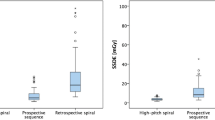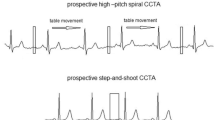Abstract
Objectives
We evaluated the potential of prospectively ECG-triggered high-pitch spiral acquisition with low tube voltage and current in combination with iterative reconstruction to achieve coronary CT angiography with sufficient image quality at an effective dose below 0.1 mSv.
Methods
Contrast-enhanced coronary dual source CT angiography (2 × 128 × 0.6 mm, 80 kV, 50 mAs) in prospectively ECG-triggered high-pitch spiral acquisition mode was performed in 21 consecutive individuals (body weight <100 kg, heart rate ≤60/min). Images were reconstructed with raw data-based filtered back projection (FBP) and iterative reconstruction (IR). Image quality was assessed on a 4-point scale (1 = no artefacts, 4 = unevaluable).
Results
Mean effective dose was 0.06 ± 0.01 mSv. Image noise was significantly reduced in IR (128.9 ± 46.6 vs. 158.2 ± 44.7 HU). The mean image quality score was lower for IR (1.9 ± 1.1 vs. 2.2 ± 1.0, P < 0.0001). Of 292 coronary segments, 55 in FBP and 40 in IR (P = 0.12) were graded “unevaluable”. In patients with a body weight ≤75 kg, both in FBP and in IR, the rates of fully evaluable segments were significantly higher in comparison to patients >75 kg.
Conclusions
Coronary CT angiography with an estimated effective dose <0.1 mSv may provide sufficient image quality in selected patients through the combination of high-pitch spiral acquisition and raw data-based iterative reconstruction.
Key Points
• Coronary CT angiography with an estimated effective dose <0.1 mSv is possible.
• Combination of high-pitch spiral acquisition with iterative reconstruction achieves sufficient image quality.
• Diagnostic accuracy remains to be assessed in future trials.



Similar content being viewed by others
References
Achenbach S, Goroll T, Seltmann M et al (2011) Detection of coronary artery stenoses by low dose, prospectively ECG-triggered, high-pitch spiral coronary CT angiography. JACC Cardiovasc Imaging 4:328–337
Budoff MJ, Dowe D, Jollis JG et al (2008) Diagnostic performance of 64-multidetector row coronary computed tomographic angiography for evaluation of coronary artery stenosis in individuals without known coronary artery disease: results from the prospective multicenter ACCURACY (Assessment by Coronary Computed Tomographic Angiography of Individuals Undergoing Invasive Coronary Angiography) trial. J Am Coll Cardiol 52:1724–1732
Chow BJ, Wells GA, Chen L et al (2010) Prognostic value of 64-slice cardiac computed tomography severity of coronary artery disease, coronary atherosclerosis, and left ventricular ejection fraction. J Am Coll Cardiol 55:1017–1028
Kerl JM, Schoepf UJ, Zwerner PL et al (2011) Accuracy of coronary artery stenosis detection with CT versus conventional coronary angiography compared with composite findings from both tests as an enhanced reference standard. Eur Radiol 21:1895–1903
van Velzen JE, Schuijf JD, de Graaf FR et al (2011) Diagnostic performance of non-invasive multidetector computed tomography coronary angiography to detect coronary artery disease using different endpoints: detection of significant stenosis vs. detection of atherosclerosis. Eur Heart J 32:637–645
Hausleiter J, Meyer T, Hermann F et al (2009) Estimated radiation dose associated with cardiac CT angiography. JAMA 30:500–507
Einstein AJ, Elliston CD, Arai AE et al (2010) Radiation dose from single-heartbeat coronary CT angiography performed with a 320-detector row volume scanner. Radiology 254:698–706
Stolzmann P, Leschka S, Scheffel H et al (2008) Dual-source CT in step-and-shoot mode: noninvasive coronary angiography with low radiation dose. Radiology 249:71–80
Scheffel H, Alkadhi H, Leschka S et al (2008) Low-dose CT coronary angiography in the step-and-shoot mode: diagnostic performance. Heart 94:1132–1137
Achenbach S, Marwan M, Schepis T et al (2009) High-pitch spiral acquisition: a new scan mode for coronary CT angiography. J Cardiovasc Comput Tomogr 3:117–121
Achenbach S, Marwan M, Ropers D et al (2010) Coronary computed tomography angiography with a consistent dose below 1 mSv using prospectively electrocardiogram-triggered high-pitch spiral acquisition. Eur Heart J 31:340–346
Vorobiof G, Achenbach S, Narula J (2012) Minimizing radiation dose for coronary CT angiography. Cardiol Clin 30:9–17
Pflederer T, Rudofsky L, Ropers D et al (2009) Image quality in a low radiation exposure protocol for retrospectively ECG-gated coronary CT angiography. AJR Am J Roentgenol 192:1045–1050
Bischoff B, Hein F, Meyer T et al (2009) Impact of a reduced tube voltage on CT angiography and radiation dose: results of the PROTECTION I study. JACC Cardiovasc Imaging 2:940–946
Leschka S, Stolzmann P, Schmid FT et al (2008) Low kilovoltage cardiac dual-source CT: attenuation, noise, and radiation dose. Eur Radiol 18:1809–1817
Blankstein R, Bolen MA, Pale R et al (2011) Use of 100 kV versus 120 kV in cardiac dual source computed tomography: effect on radiation dose and image quality. Int J Cardiovasc Imaging 27:579–586
Winklehner A, Karlo C, Puippe G et al (2011) Raw data-based iterative reconstruction in body CTA: evaluation of radiation dose saving potential. Eur Radiol 21:2521–2526
Bittencourt MS, Schmidt B, Seltmann M et al (2011) Iterative reconstruction in image space (IRIS) in cardiac computed tomography: initial experience. Int J Cardiovasc Imaging 27:1081–1087
Leipsic J, LaBounty TM, Heilbron G et al (2010) Adaptive statistical iterative reconstruction: assessment of image noise and image quality in coronary CT angiography. AJR Am J Roentgenol 195:649–654
Moscariello A, Takx RA, Schoepf UJ et al (2011) Coronary CT angiography: image quality, diagnostic accuracy, and potential for radiation dose reduction using a novel iterative image reconstruction technique-comparison with traditional filtered back projection. Eur Radiol 21:2130–2138
Utsunomiya D, Weigold WG, Weissman G et al (2012) Effect of hybrid iterative reconstruction technique on quantitative and qualitative image analysis at 256-slice prospective gating cardiac CT. Eur Radiol 22:1287–1294
Leipsic J, Nguyen G, Brown J et al (2010) A prospective evaluation of dose reduction and image quality in chest CT using adaptive statistical iterative reconstruction. AJR Am J Roentgenol 195:1095–1099
Marin D, Nelson RC, Schindera ST et al (2010) Low-tube-voltage, high-tube-current multidetector abdominal CT: improved image quality and decreased radiation dose with adaptive statistical iterative reconstruction algorithm–initial clinical experience. Radiology 254:145–153
Leipsic J, Labounty TM, Heilbron B et al (2010) Estimated radiation dose reduction using adaptive statistical iterative reconstruction in coronary CT angiography: the ERASIR study. AJR Am J Roentgenol 195:655–660
Renker M, Ramachandra A, Schoepf UJ et al (2011) Iterative image reconstruction techniques: applications for cardiac CT. J Cardiovasc Comput Tomogr 5:225–230
Raff GL, Abidov A, Achenbach S et al (2009) SCCT guidelines for the interpretation and reporting of coronary computed tomographic angiography. J Cardiovasc Comput Tomogr 3:122–136
Achenbach S, Giesler T, Ropers D et al (2006) Comparison of image quality in contrast-enhanced coronary artery visualization by electron-beam tomography and retrospectively electrocardiogram-gated multislice spiral computed tomography. Eur J Radiol 57:373–379
Bongartz G, Golding SJ, Jurik AG et al (2004) European Guidelines for Multislice Computed Tomography: Appendix C Funded by the European Commission. Contract number FIGM-CT2000-20078-CT-TIP. Available via http://w3.tue.nl/fileadmin/sbd/Documenten/Leergang/BSM/European_Guidelines_Quality_Criteria_Computed_Tomography_Eur_16252.pdf. Accessed 04 June 2012
Halliburton SS, Abbara S, Chen MY et al (2011) SCCT guidelines on radiation dose and dose-optimization strategies in cardiovascular CT. J Cardiovasc Comput Tomogr 5:198–224
Gosling O, Loader R, Venables P et al (2010) A comparison of radiation doses between state-of-the-art multislice CT coronary angiography with iterative reconstruction, multislice CT coronary angiography with standard filtered back-projection and invasive diagnostic coronary angiography. Heart 96:922–926
Neefjes LA, Dharampal AS, Rossi A et al (2011) Image quality and radiation exposure using different low-dose scan protocols in dual-source CT coronary angiography: randomized study. Radiology 261:779–786
Acknowledgments
This study was supported by the German Government, Bundesministerium für Bildung und Forschung (01EX1012B, “Spitzencluster Medical Valley”)
Author information
Authors and Affiliations
Corresponding author
Rights and permissions
About this article
Cite this article
Schuhbaeck, A., Achenbach, S., Layritz, C. et al. Image quality of ultra-low radiation exposure coronary CT angiography with an effective dose <0.1 mSv using high-pitch spiral acquisition and raw data-based iterative reconstruction. Eur Radiol 23, 597–606 (2013). https://doi.org/10.1007/s00330-012-2656-2
Received:
Revised:
Accepted:
Published:
Issue Date:
DOI: https://doi.org/10.1007/s00330-012-2656-2




